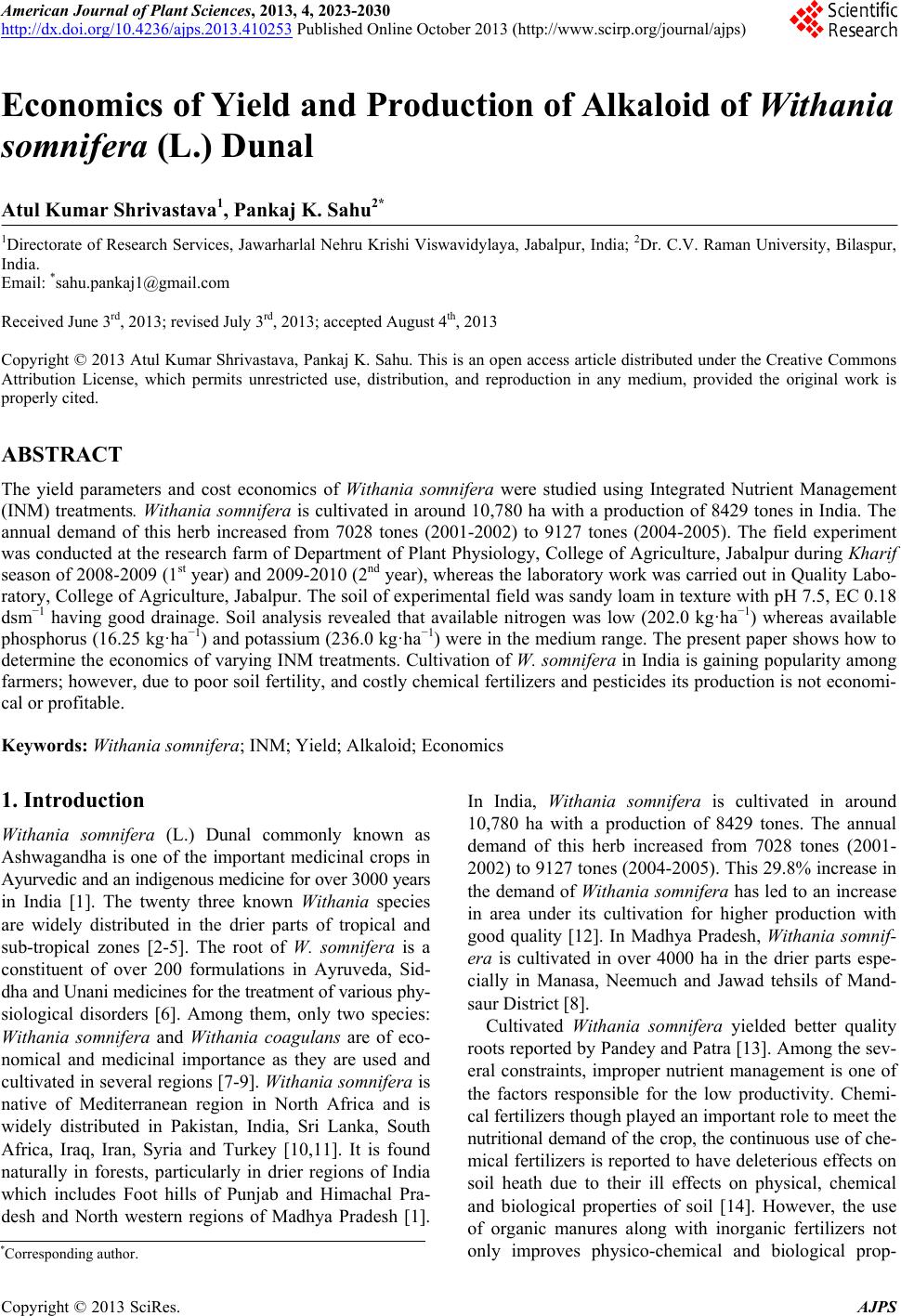 American Journal of Plant Sciences, 2013, 4, 2023-2030 http://dx.doi.org/10.4236/ajps.2013.410253 Published Online October 2013 (http://www.scirp.org/journal/ajps) 2023 Economics of Yield and Production of Alkaloid of Withania somnifera (L.) Dunal Atul Kumar Shrivastava1, Pankaj K. Sahu2* 1Directorate of Research Services, Jawarharlal Nehru Krishi Viswavidylaya, Jabalpur, India; 2Dr. C.V. Raman University, Bilaspur, India. Email: *sahu.pankaj1@gmail.com Received June 3rd, 2013; revised July 3rd, 2013; accepted August 4th, 2013 Copyright © 2013 Atul Kumar Shrivastava, Pankaj K. Sahu. This is an open access article distributed under the Creative Commons Attribution License, which permits unrestricted use, distribution, and reproduction in any medium, provided the original work is properly cited. ABSTRACT The yield parameters and cost economics of Withania somnifera were studied using Integrated Nutrient Management (INM) treatments. Withania somnifera is cultivated in around 10,780 ha with a production of 8429 tones in India. The annual demand of this herb increased from 7028 tones (2001-2002) to 9127 tones (2004-2005). The field experiment was conducted at the research farm of Department of Plant Physiology, College of Agriculture, Jabalpur during Kharif season of 2008-2009 (1st year) and 2009-2010 (2nd year), whereas the laboratory work was carried out in Quality Labo- ratory, College of Agriculture, Jabalpur. The soil of experimental field was sandy loam in texture with pH 7.5, EC 0.18 dsm−1 having good drainage. Soil analysis revealed that available nitrogen was low (202.0 kg·ha−1) whereas available phosphorus (16.25 kg·ha−1) and potassium (236.0 kg·ha−1) were in the medium range. The present paper shows how to determine the economics of varying INM treatments. Cultivation of W. somnifera in India is gaining popularity among farmers; however, due to poor soil fertility, and costly chemical fertilizers and pesticides its production is not economi- cal or profitable. Keywords: Withania somnifera; INM; Yield; Alkaloid; Economics 1. Introduction Withania somnifera (L.) Dunal commonly known as Ashwagandha is one of the important medicinal crops in Ayurvedic and an indigenous medicine for over 3000 years in India [1]. The twenty three known Withania species are widely distributed in the drier parts of tropical and sub-tropical zones [2-5]. The root of W. somnifera is a constituent of over 200 formulations in Ayruveda, Sid- dha and Unani medicines for the treatment of various phy- siological disorders [6]. Among them, only two species: Withania somnifera and Withania coagulans are of eco- nomical and medicinal importance as they are used and cultivated in several regions [7-9]. Withania somn ifera is native of Mediterranean region in North Africa and is widely distributed in Pakistan, India, Sri Lanka, South Africa, Iraq, Iran, Syria and Turkey [10,11]. It is found naturally in forests, particularly in drier regions of India which includes Foot hills of Punjab and Himachal Pra- desh and North western regions of Madhya Pradesh [1]. In India, Withania somnifera is cultivated in around 10,780 ha with a production of 8429 tones. The annual demand of this herb increased from 7028 tones (2001- 2002) to 9127 tones (2004-2005). This 29.8% increase in the demand of Withania somnifera has led to an increase in area under its cultivation for higher production with good quality [12]. In Madhya Pradesh, Withania somnif- era is cultivated in over 4000 ha in the drier parts espe- cially in Manasa, Neemuch and Jawad tehsils of Mand- saur District [8]. Cultivated Withania somnifera yielded better quality roots reported by Pandey and Patra [13]. Among the sev- eral constraints, improper nutrient management is one of the factors responsible for the low productivity. Chemi- cal fertilizers though played an important role to meet the nutritional demand of the crop, the continuous use of che- mical fertilizers is reported to have deleterious effects on soil heath due to their ill effects on physical, chemical and biological properties of soil [14]. However, the use of organic manures along with inorganic fertilizers not only improves physico-chemical and biological prop- *Corresponding author. Copyright © 2013 SciRes. AJPS 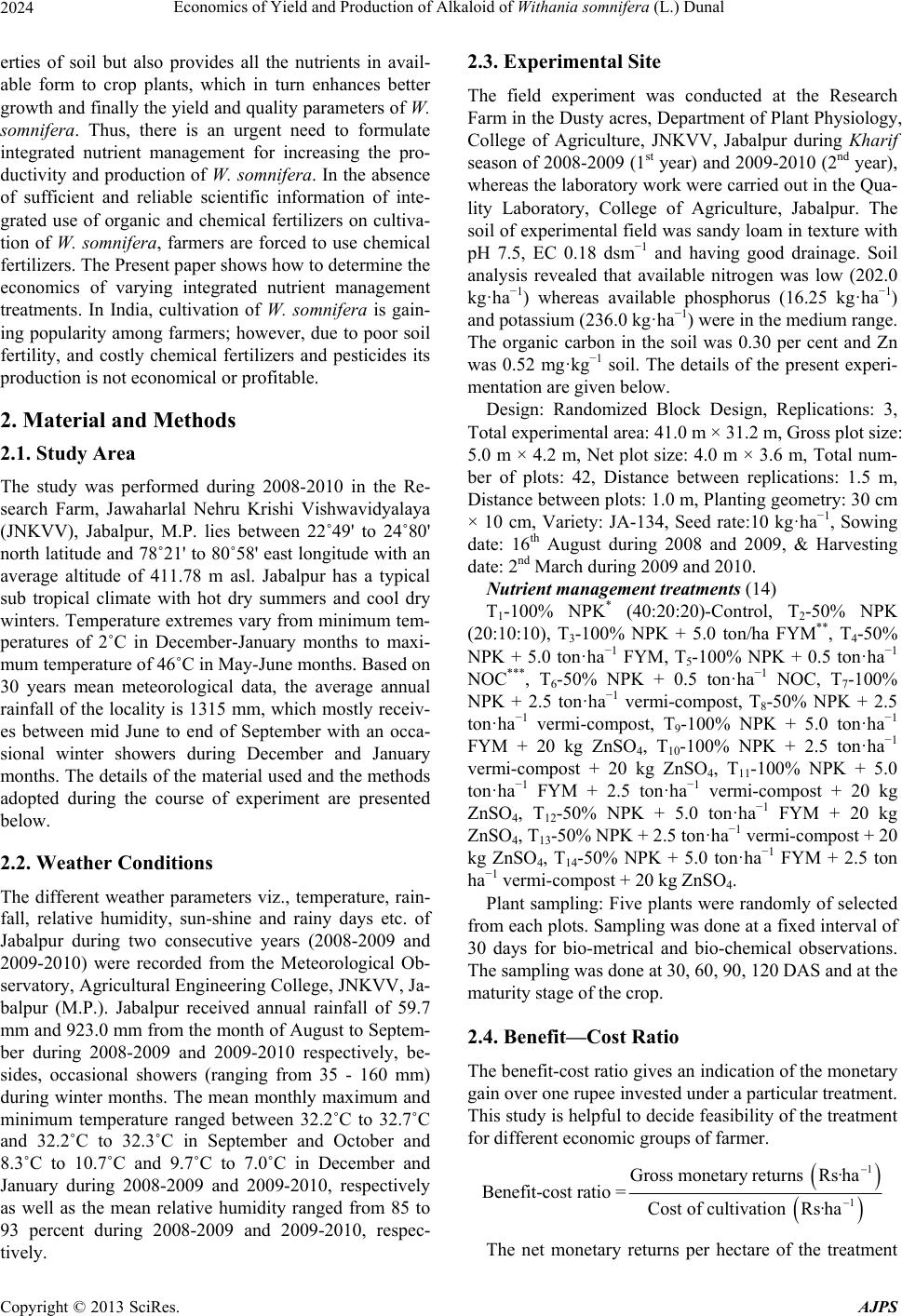 Economics of Yield and Production of Alkaloid of Withania somnifera (L.) Dunal 2024 erties of soil but also provides all the nutrients in avail- able form to crop plants, which in turn enhances better growth and finally the yield and quality parameters of W. somnifera. Thus, there is an urgent need to formulate integrated nutrient management for increasing the pro- ductivity and production of W. somn ifera. In the absence of sufficient and reliable scientific information of inte- grated use of organic and chemical fertilizers on cultiva- tion of W. somnifera, farmers are forced to use chemical fertilizers. The Present paper shows how to determine the economics of varying integrated nutrient management treatments. In India, cultivation of W. somnifera is gain- ing popularity among farmers; however, due to poor soil fertility, and costly chemical fertilizers and pesticides its production is not economical or profitable. 2. Material and Methods 2.1. Study Area The study was performed during 2008-2010 in the Re- search Farm, Jawaharlal Nehru Krishi Vishwavidyalaya (JNKVV), Jabalpur, M.P. lies between 22˚49' to 24˚80' north latitude and 78˚21' to 80˚58' east longitude with an average altitude of 411.78 m asl. Jabalpur has a typical sub tropical climate with hot dry summers and cool dry winters. Temperature extremes vary from minimum tem- peratures of 2˚C in December-January months to maxi- mum temperature of 46˚C in May-June months. Based on 30 years mean meteorological data, the average annual rainfall of the locality is 1315 mm, which mostly receiv- es between mid June to end of September with an occa- sional winter showers during December and January months. The details of the material used and the methods adopted during the course of experiment are presented below. 2.2. Weather Conditions The different weather parameters viz., temperature, rain- fall, relative humidity, sun-shine and rainy days etc. of Jabalpur during two consecutive years (2008-2009 and 2009-2010) were recorded from the Meteorological Ob- servatory, Agricultural Engineering College, JNKVV, Ja- balpur (M.P.). Jabalpur received annual rainfall of 59.7 mm and 923.0 mm from the month of August to Septem- ber during 2008-2009 and 2009-2010 respectively, be- sides, occasional showers (ranging from 35 - 160 mm) during winter months. The mean monthly maximum and minimum temperature ranged between 32.2˚C to 32.7˚C and 32.2˚C to 32.3˚C in September and October and 8.3˚C to 10.7˚C and 9.7˚C to 7.0˚C in December and January during 2008-2009 and 2009-2010, respectively as well as the mean relative humidity ranged from 85 to 93 percent during 2008-2009 and 2009-2010, respec- tively. 2.3. Experimental Site The field experiment was conducted at the Research Farm in the Dusty acres, Department of Plant Physiology, College of Agriculture, JNKVV, Jabalpur during Kharif season of 2008-2009 (1st year) and 2009-2010 (2nd year), whereas the laboratory work were carried out in the Qua- lity Laboratory, College of Agriculture, Jabalpur. The soil of experimental field was sandy loam in texture with pH 7.5, EC 0.18 dsm−1 and having good drainage. Soil analysis revealed that available nitrogen was low (202.0 kg·ha−1) whereas available phosphorus (16.25 kg·ha−1) and potassium (236.0 kg·ha−1) were in the medium range. The organic carbon in the soil was 0.30 per cent and Zn was 0.52 mg·kg−1 soil. The details of the present experi- mentation are given below. Design: Randomized Block Design, Replications: 3, Total experimental area: 41.0 m × 31.2 m, Gross plot size: 5.0 m × 4.2 m, Net plot size: 4.0 m × 3.6 m, Total num- ber of plots: 42, Distance between replications: 1.5 m, Distance between plots: 1.0 m, Planting geometry: 30 cm × 10 cm, Variety: JA-134, Seed rate:10 kg·ha−1, Sowing date: 16th August during 2008 and 2009, & Harvesting date: 2nd March during 2009 and 2010. Nutrient management treatments (14) T1-100% NPK* (40:20:20)-Control, T2-50% NPK (20:10:10), T3-100% NPK + 5.0 ton/ha FYM**, T4-50% NPK + 5.0 ton·ha−1 FYM, T5-100% NPK + 0.5 ton·ha−1 NOC***, T6-50% NPK + 0.5 ton·ha−1 NOC, T7-100% NPK + 2.5 ton·ha−1 vermi-compost, T8-50% NPK + 2.5 ton·ha−1 vermi-compost, T9-100% NPK + 5.0 ton·ha−1 FYM + 20 kg ZnSO4, T10-100% NPK + 2.5 ton·ha−1 vermi-compost + 20 kg ZnSO4, T11-100% NPK + 5.0 ton·ha−1 FYM + 2.5 ton·ha−1 vermi-compost + 20 kg ZnSO4, T12-50% NPK + 5.0 ton·ha−1 FYM + 20 kg ZnSO4, T13-50% NPK + 2.5 ton·ha−1 vermi-compost + 20 kg ZnSO4, T14-50% NPK + 5.0 ton·ha−1 FYM + 2.5 ton ha−1 vermi-compost + 20 kg ZnSO4. Plant sampling: Five plants were randomly of selected from each plots. Sampling was done at a fixed interval of 30 days for bio-metrical and bio-chemical observations. The sampling was done at 30, 60, 90, 120 DAS and at the maturity stage of the crop. 2.4. Benefit—Cost Ratio The benefit-cost ratio gives an indication of the monetary gain over one rupee invested under a particular treatment. This study is helpful to decide feasibility of the treatment for different economic groups of farmer. 1 1 Gross monetary returns Rsha Benefit-cost ratio =Cost of cultivation Rs · ·ha The net monetary returns per hectare of the treatment Copyright © 2013 SciRes. AJPS 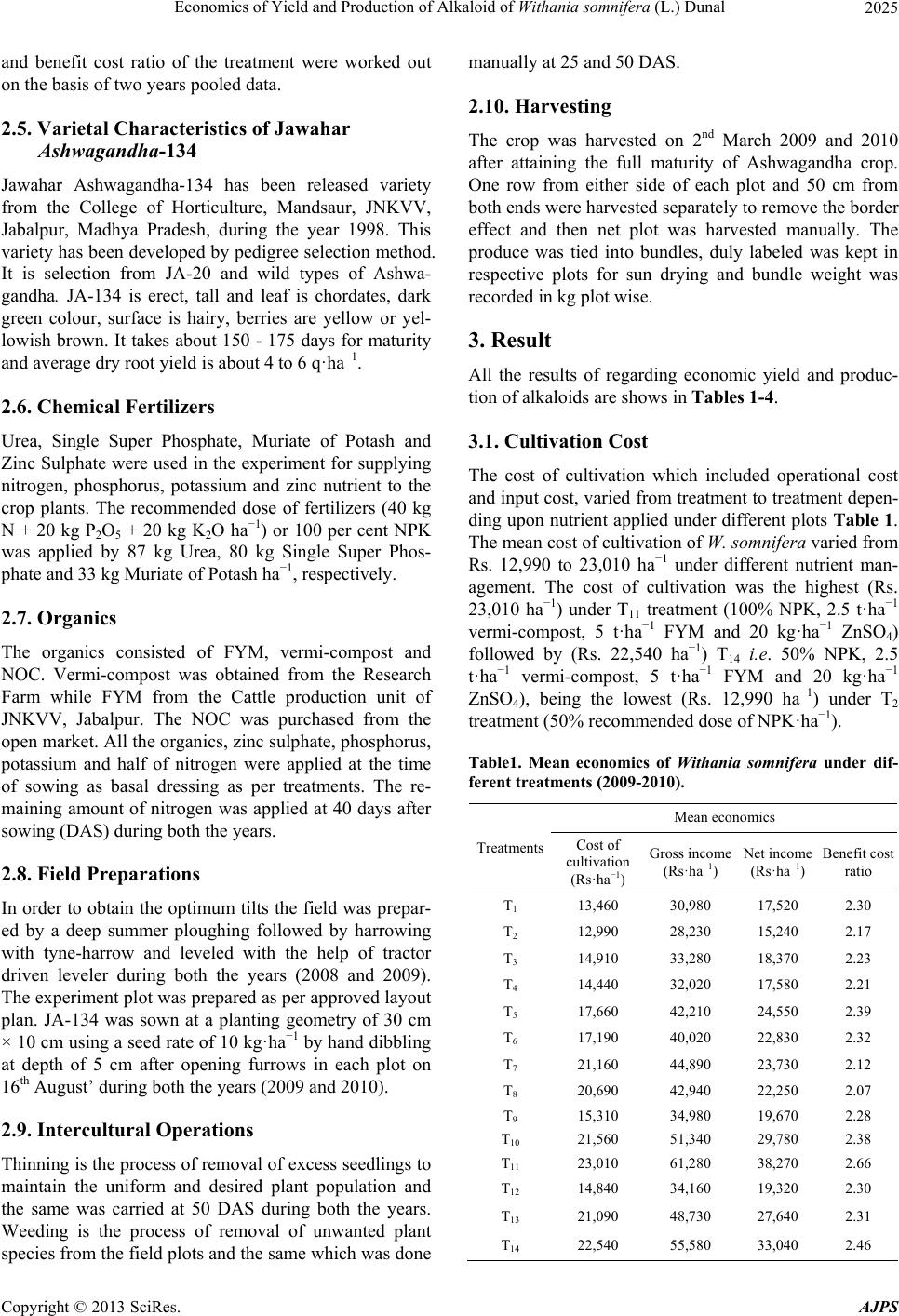 Economics of Yield and Production of Alkaloid of Withania somnifera (L.) Dunal 2025 and benefit cost ratio of the treatment were worked out on the basis of two years pooled data. 2.5. Varietal Characteristics of Jawahar Ashwagandha-134 Jawahar Ashwagandha-134 has been released variety from the College of Horticulture, Mandsaur, JNKVV, Jabalpur, Madhya Pradesh, during the year 1998. This variety has been developed by pedigree selection method. It is selection from JA-20 and wild types of Ashwa- gandha. JA-134 is erect, tall and leaf is chordates, dark green colour, surface is hairy, berries are yellow or yel- lowish brown. It takes about 150 - 175 days for maturity and average dry root yield is about 4 to 6 q·ha−1. 2.6. Chemical Fertilizers Urea, Single Super Phosphate, Muriate of Potash and Zinc Sulphate were used in the experiment for supplying nitrogen, phosphorus, potassium and zinc nutrient to the crop plants. The recommended dose of fertilizers (40 kg N + 20 kg P2O5 + 20 kg K2O ha−1) or 100 per cent NPK was applied by 87 kg Urea, 80 kg Single Super Phos- phate and 33 kg Muriate of Potash ha−1, respectively. 2.7. Organics The organics consisted of FYM, vermi-compost and NOC. Vermi-compost was obtained from the Research Farm while FYM from the Cattle production unit of JNKVV, Jabalpur. The NOC was purchased from the open market. All the organics, zinc sulphate, phosphorus, potassium and half of nitrogen were applied at the time of sowing as basal dressing as per treatments. The re- maining amount of nitrogen was applied at 40 days after sowing (DAS) during both the years. 2.8. Field Preparations In order to obtain the optimum tilts the field was prepar- ed by a deep summer ploughing followed by harrowing with tyne-harrow and leveled with the help of tractor driven leveler during both the years (2008 and 2009). The experiment plot was prepared as per approved layout plan. JA-134 was sown at a planting geometry of 30 cm × 10 cm using a seed rate of 10 kg·ha−1 by hand dibbling at depth of 5 cm after opening furrows in each plot on 16th August’ during both the years (2009 and 2010). 2.9. Intercultural Operations Thinning is the process of removal of excess seedlings to maintain the uniform and desired plant population and the same was carried at 50 DAS during both the years. Weeding is the process of removal of unwanted plant species from the field plots and the same which was done manually at 25 and 50 DAS. 2.10. Harvesting The crop was harvested on 2nd March 2009 and 2010 after attaining the full maturity of Ashwagandha crop. One row from either side of each plot and 50 cm from both ends were harvested separately to remove the border effect and then net plot was harvested manually. The produce was tied into bundles, duly labeled was kept in respective plots for sun drying and bundle weight was recorded in kg plot wise. 3. Result All the results of regarding economic yield and produc- tion of alkaloids are shows in Tables 1-4. 3.1. Cultivation Cost The cost of cultivation which included operational cost and input cost, varied from treatment to treatment depen- ding upon nutrient applied under different plots Table 1. The mean cost of cultivation of W. somnifera varied from Rs. 12,990 to 23,010 ha−1 under different nutrient man- agement. The cost of cultivation was the highest (Rs. 23,010 ha−1) under T11 treatment (100% NPK, 2.5 t·ha−1 vermi-compost, 5 t·ha−1 FYM and 20 kg·ha−1 ZnSO4) followed by (Rs. 22,540 ha−1) T14 i.e. 50% NPK, 2.5 t·ha−1 vermi-compost, 5 t·ha−1 FYM and 20 kg·ha−1 ZnSO4), being the lowest (Rs. 12,990 ha−1) under T2 treatment (50% recommended dose of NPK·ha−1). Table1. Mean economics of Withania somnifera under dif- ferent treatments (2009-2010). Mean economics Treatments Cost of cultivation (Rs·ha−1) Gross income (Rs·ha−1) Net income (Rs·ha−1) Benefit cost ratio T1 13,460 30,980 17,520 2.30 T2 12,990 28,230 15,240 2.17 T3 14,910 33,280 18,370 2.23 T4 14,440 32,020 17,580 2.21 T5 17,660 42,210 24,550 2.39 T6 17,190 40,020 22,830 2.32 T7 21,160 44,890 23,730 2.12 T8 20,690 42,940 22,250 2.07 T9 15,310 34,980 19,670 2.28 T10 21,560 51,340 29,780 2.38 T11 23,010 61,280 38,270 2.66 T12 14,840 34,160 19,320 2.30 T13 21,090 48,730 27,640 2.31 T14 22,540 55,580 33,040 2.46 Copyright © 2013 SciRes. AJPS 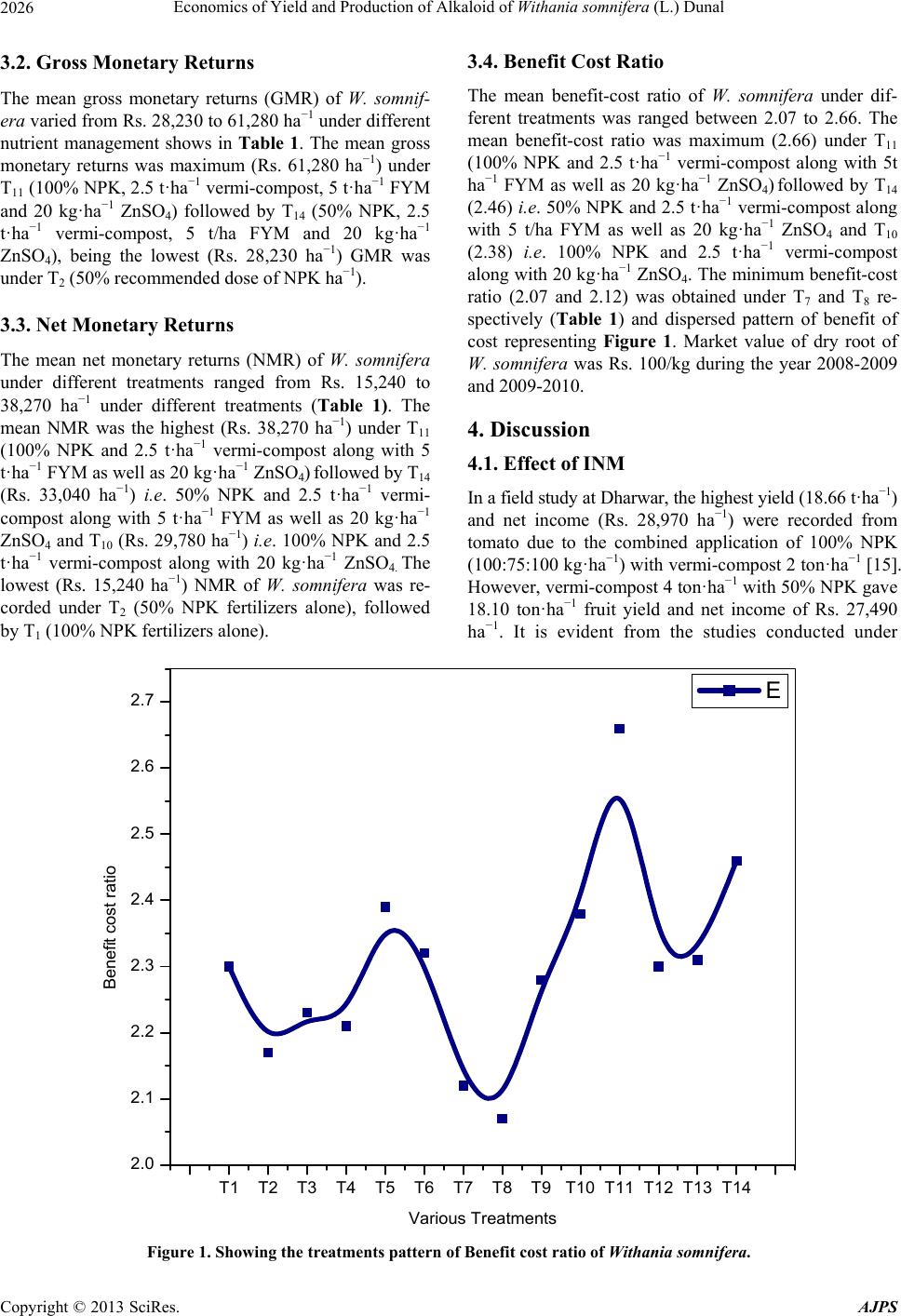 Economics of Yield and Production of Alkaloid of Withania somnifera (L.) Dunal Copyright © 2013 SciRes. AJPS 2026 3.4. Benefit Cost Ratio 3.2. Gross Monetary Returns The mean benefit-cost ratio of W. somnifera under dif- ferent treatments was ranged between 2.07 to 2.66. The mean benefit-cost ratio was maximum (2.66) under T11 (100% NPK and 2.5 t·ha−1 vermi-compost along with 5t ha−1 FYM as well as 20 kg·ha−1 ZnSO4) followed by T14 (2.46) i.e. 50% NPK and 2.5 t·ha−1 vermi-compost along with 5 t/ha FYM as well as 20 kg·ha−1 ZnSO4 and T10 (2.38) i.e. 100% NPK and 2.5 t·ha−1 vermi-compost along with 20 kg·ha−1 ZnSO4. The minimum benefit-cost ratio (2.07 and 2.12) was obtained under T7 and T8 re- spectively (Table 1) and dispersed pattern of benefit of cost representing Figure 1. Market value of dry root of W. somnifera was Rs. 100/kg during the year 2008-2009 and 2009-2010. The mean gross monetary returns (GMR) of W. somnif- era varied from Rs. 28,230 to 61,280 ha−1 under different nutrient management shows in Table 1. The mean gross monetary returns was maximum (Rs. 61,280 ha−1) under T11 (100% NPK, 2.5 t·ha−1 vermi-compost, 5 t·ha−1 FYM and 20 kg·ha−1 ZnSO4) followed by T14 (50% NPK, 2.5 t·ha−1 vermi-compost, 5 t/ha FYM and 20 kg·ha−1 ZnSO4), being the lowest (Rs. 28,230 ha−1) GMR was under T2 (50% recommended dose of NPK ha−1). 3.3. Net Monetary Returns The mean net monetary returns (NMR) of W. somnifera under different treatments ranged from Rs. 15,240 to 38,270 ha−1 under different treatments (Table 1). The mean NMR was the highest (Rs. 38,270 ha−1) under T11 (100% NPK and 2.5 t·ha−1 vermi-compost along with 5 t·ha−1 FYM as well as 20 kg·ha−1 ZnSO4) followed by T14 (Rs. 33,040 ha−1) i.e. 50% NPK and 2.5 t·ha−1 vermi- compost along with 5 t·ha−1 FYM as well as 20 kg·ha−1 ZnSO4 and T10 (Rs. 29,780 ha−1) i.e. 100% NPK and 2.5 t·ha−1 vermi-compost along with 20 kg·ha−1 ZnSO4. The lowest (Rs. 15,240 ha−1) NMR of W. somnifera was re- corded under T2 (50% NPK fertilizers alone), followed by T1 (100% NPK fertilizers alone). 4. Discussion 4.1. Effect of INM In a field study at Dharwar, the highest yield (18.66 t·ha−1) and net income (Rs. 28,970 ha−1) were recorded from tomato due to the combined application of 100% NPK (100:75:100 kg·ha−1) with vermi-compost 2 ton·ha−1 [15]. However, vermi-compost 4 ton·ha−1 with 50% NPK gave 18.10 ton·ha−1 fruit yield and net income of Rs. 27,490 ha−1. It is evident from the studies conducted under T1 T2 T3 T4 T5 T6 T7 T8 T9T10T11T12T13T14 2.0 2.1 2.2 2.3 2.4 2.5 2.6 2.7 Benefit cost ratio Various Treatments E Figure 1. Showing the treatments pattern of Benefit cost ratio of Withania somnifera. 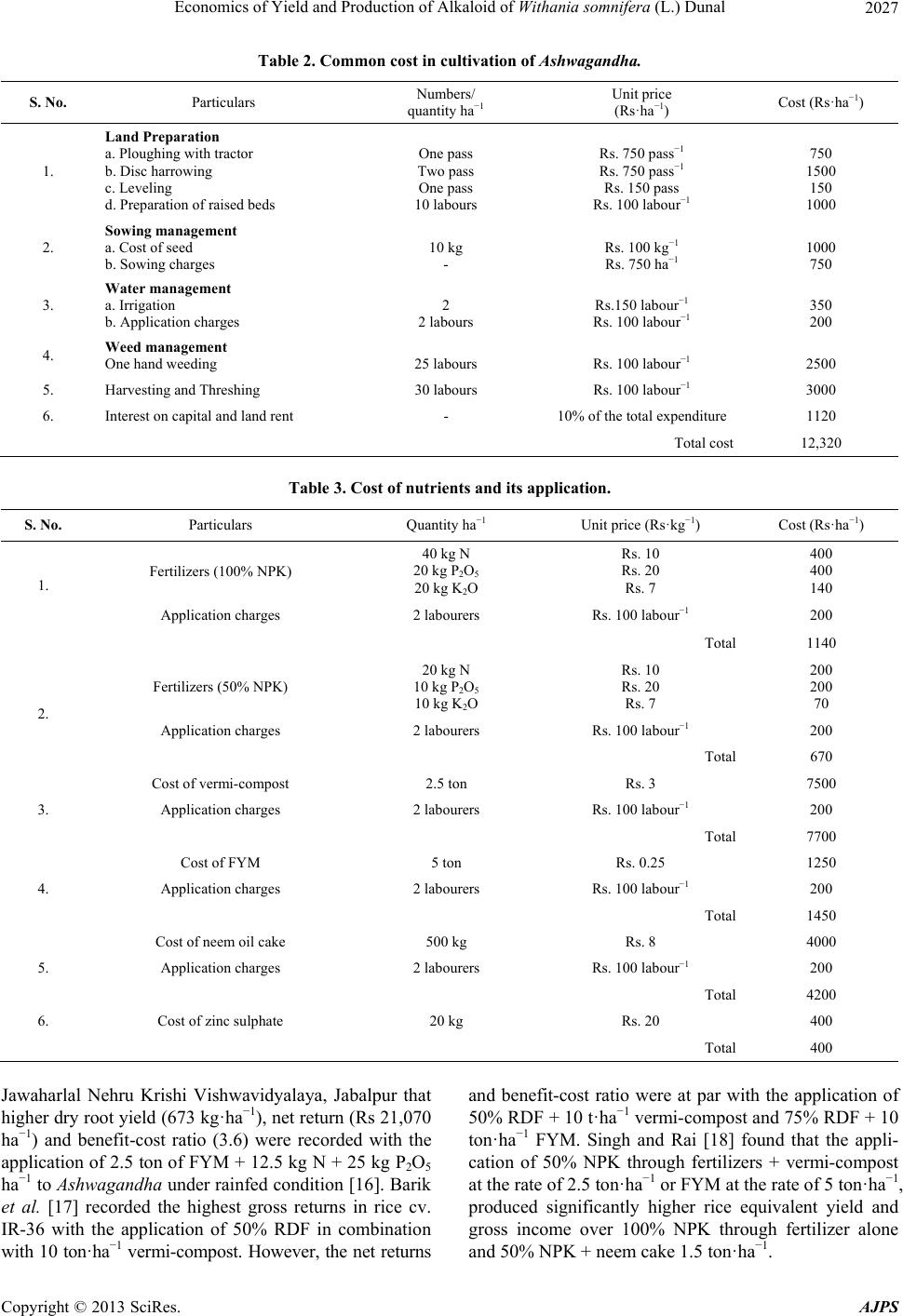 Economics of Yield and Production of Alkaloid of Withania somnifera (L.) Dunal 2027 Table 2. Common cost in cultivation of Ashwagandha. S. No. Particulars Numbers/ quantity ha−1 Unit price (Rs·ha−1) Cost (Rs·ha−1) 1. Land Preparation a. Ploughing with tractor b. Disc harrowing c. Leveling d. Preparation of raised beds One pass Two pass One pass 10 labours Rs. 750 pass−1 Rs. 750 pass−1 Rs. 150 pass Rs. 100 labour−1 750 1500 150 1000 2. Sowing management a. Cost of seed b. Sowing charges 10 kg - Rs. 100 kg−1 Rs. 750 ha−1 1000 750 3. Water management a. Irrigation b. Application charges 2 2 labours Rs.150 labour−1 Rs. 100 labour−1 350 200 4. Weed management One hand weeding 25 labours Rs. 100 labour−1 2500 5. Harvesting and Threshing 30 labours Rs. 100 labour−1 3000 6. Interest on capital and land rent - 10% of the total expenditure 1120 Total cost 12,320 Table 3. Cost of nutrients and its application. S. No. Particulars Quantity ha−1 Unit price (Rs·kg−1) Cost (Rs·ha−1) Fertilizers (100% NPK) 40 kg N 20 kg P2O5 20 kg K2O Rs. 10 Rs. 20 Rs. 7 400 400 140 1. Application charges 2 labourers Rs. 100 labour−1 200 Total 1140 Fertilizers (50% NPK) 20 kg N 10 kg P2O5 10 kg K2O Rs. 10 Rs. 20 Rs. 7 200 200 70 Application charges 2 labourers Rs. 100 labour−1 200 2. Total 670 Cost of vermi-compost 2.5 ton Rs. 3 7500 Application charges 2 labourers Rs. 100 labour−1 200 3. Total 7700 Cost of FYM 5 ton Rs. 0.25 1250 Application charges 2 labourers Rs. 100 labour−1 200 4. Total 1450 Cost of neem oil cake 500 kg Rs. 8 4000 Application charges 2 labourers Rs. 100 labour−1 200 5. Total 4200 6. Cost of zinc sulphate 20 kg Rs. 20 400 Total 400 Jawaharlal Nehru Krishi Vishwavidyalaya, Jabalpur that higher dry root yield (673 kg·ha−1), net return (Rs 21,070 ha−1) and benefit-cost ratio (3.6) were recorded with the application of 2.5 ton of FYM + 12.5 kg N + 25 kg P2O5 ha−1 to Ashwagandha under rainfed condition [16]. Barik et al. [17] recorded the highest gross returns in rice cv. IR-36 with the application of 50% RDF in combination with 10 ton·ha−1 vermi-compost. However, the net returns and benefit-cost ratio were at par with the application of 50% RDF + 10 t·ha−1 vermi-compost and 75% RDF + 10 ton·ha−1 FYM. Singh and Rai [18] found that the appli- cation of 50% NPK through fertilizers + vermi-compost at the rate of 2.5 ton·ha−1 or FYM at the rate of 5 ton·ha−1, produced significantly higher rice equivalent yield and gross income over 100% NPK through fertilizer alone and 50% NPK + neem cake 1.5 ton·ha−1. Copyright © 2013 SciRes. AJPS 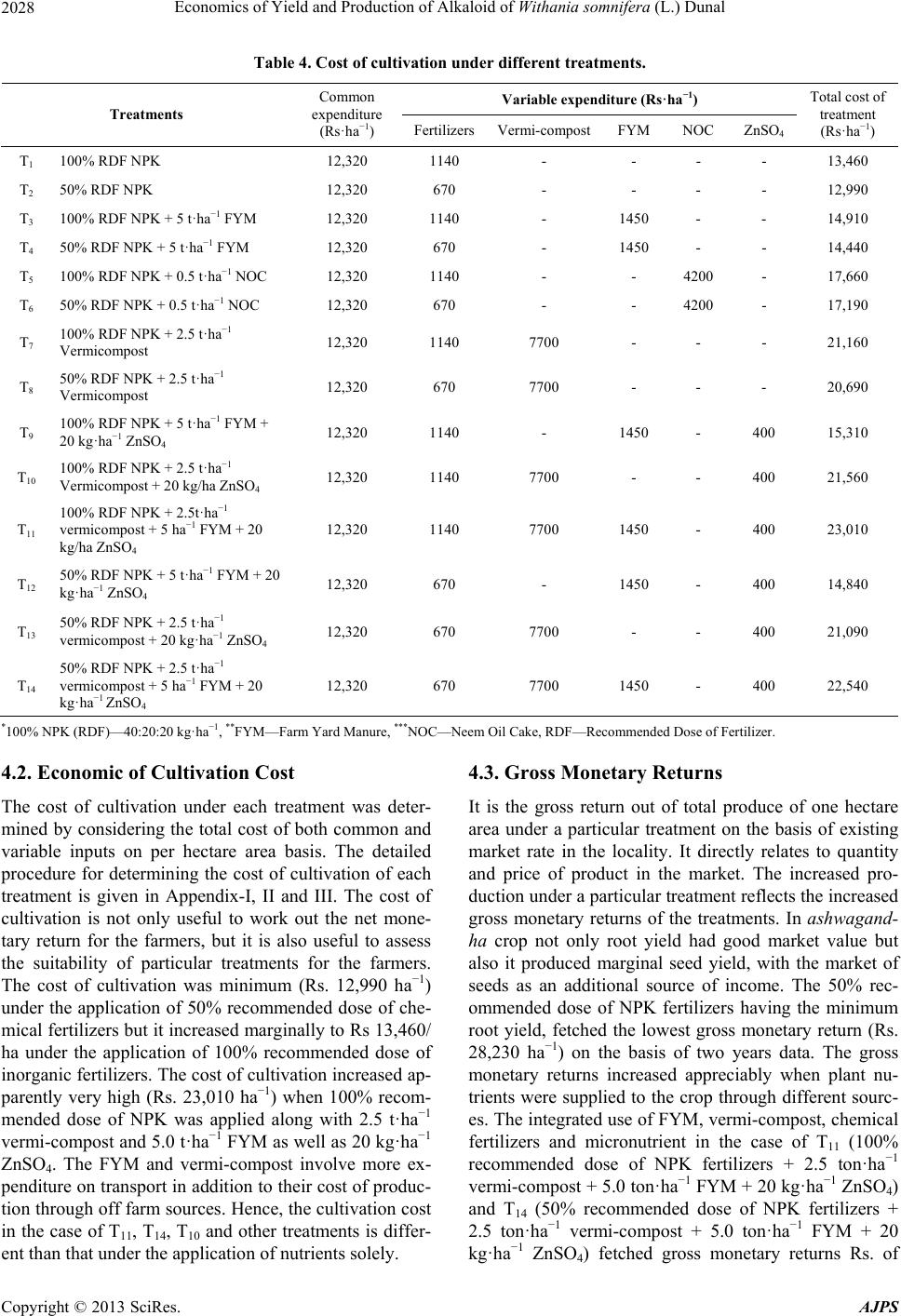 Economics of Yield and Production of Alkaloid of Withania somnifera (L.) Dunal 2028 Table 4. Cost of cultivation under different treatments. Variable expenditure (Rs·ha−1) Treatments Common expenditure (Rs·ha−1) FertilizersVermi-compostFYM NOC ZnSO4 Total cost of treatment (Rs·ha−1) T1 100% RDF NPK 12,320 1140 - - - - 13,460 T2 50% RDF NPK 12,320 670 - - - - 12,990 T3 100% RDF NPK + 5 t·ha−1 FYM 12,320 1140 - 1450 - - 14,910 T4 50% RDF NPK + 5 t·ha−1 FYM 12,320 670 - 1450 - - 14,440 T5 100% RDF NPK + 0.5 t·ha−1 NOC 12,320 1140 - - 4200 - 17,660 T6 50% RDF NPK + 0.5 t·ha−1 NOC 12,320 670 - - 4200 - 17,190 T7 100% RDF NPK + 2.5 t·ha−1 Vermicompost 12,320 1140 7700 - - - 21,160 T8 50% RDF NPK + 2.5 t·ha−1 Vermicompost 12,320 670 7700 - - - 20,690 T9 100% RDF NPK + 5 t·ha−1 FYM + 20 kg·ha−1 ZnSO4 12,320 1140 - 1450 - 400 15,310 T10 100% RDF NPK + 2.5 t·ha−1 Vermicompost + 20 kg/ha ZnSO4 12,320 1140 7700 - - 400 21,560 T11 100% RDF NPK + 2.5t·ha−1 vermicompost + 5 ha−1 FYM + 20 kg/ha ZnSO4 12,320 1140 7700 1450 - 400 23,010 T12 50% RDF NPK + 5 t·ha−1 FYM + 20 kg·ha−1 ZnSO4 12,320 670 - 1450 - 400 14,840 T13 50% RDF NPK + 2.5 t·ha−1 vermicompost + 20 kg·ha−1 ZnSO4 12,320 670 7700 - - 400 21,090 T14 50% RDF NPK + 2.5 t·ha−1 vermicompost + 5 ha−1 FYM + 20 kg·ha−1 ZnSO4 12,320 670 7700 1450 - 400 22,540 *100% NPK (RDF)—40:20:20 kg·ha−1, **FYM—Farm Yard Manure, ***NOC—Neem Oil Cake, RDF—Recommended Dose of Fertilizer. 4.2. Economic of Cultivation Cost The cost of cultivation under each treatment was deter- mined by considering the total cost of both common and variable inputs on per hectare area basis. The detailed procedure for determining the cost of cultivation of each treatment is given in Appendix-I, II and III. The cost of cultivation is not only useful to work out the net mone- tary return for the farmers, but it is also useful to assess the suitability of particular treatments for the farmers. The cost of cultivation was minimum (Rs. 12,990 ha−1) under the application of 50% recommended dose of che- mical fertilizers but it increased marginally to Rs 13,460/ ha under the application of 100% recommended dose of inorganic fertilizers. The cost of cultivation increased ap- parently very high (Rs. 23,010 ha−1) when 100% recom- mended dose of NPK was applied along with 2.5 t·ha−1 vermi-compost and 5.0 t·ha−1 FYM as well as 20 kg·ha−1 ZnSO4. The FYM and vermi-compost involve more ex- penditure on transport in addition to their cost of produc- tion through off farm sources. Hence, the cultivation cost in the case of T11, T14, T10 and other treatments is differ- ent than that under the application of nutrients solely. 4.3. Gross Monetary Returns It is the gross return out of total produce of one hectare area under a particular treatment on the basis of existing market rate in the locality. It directly relates to quantity and price of product in the market. The increased pro- duction under a particular treatment reflects the increased gross monetary returns of the treatments. In ashwagand- ha crop not only root yield had good market value but also it produced marginal seed yield, with the market of seeds as an additional source of income. The 50% rec- ommended dose of NPK fertilizers having the minimum root yield, fetched the lowest gross monetary return (Rs. 28,230 ha−1) on the basis of two years data. The gross monetary returns increased appreciably when plant nu- trients were supplied to the crop through different sourc- es. The integrated use of FYM, vermi-compost, chemical fertilizers and micronutrient in the case of T11 (100% recommended dose of NPK fertilizers + 2.5 ton·ha−1 vermi-compost + 5.0 ton·ha−1 FYM + 20 kg·ha−1 ZnSO4) and T14 (50% recommended dose of NPK fertilizers + 2.5 ton·ha−1 vermi-compost + 5.0 ton·ha−1 FYM + 20 kg·ha−1 ZnSO4) fetched gross monetary returns Rs. of Copyright © 2013 SciRes. AJPS 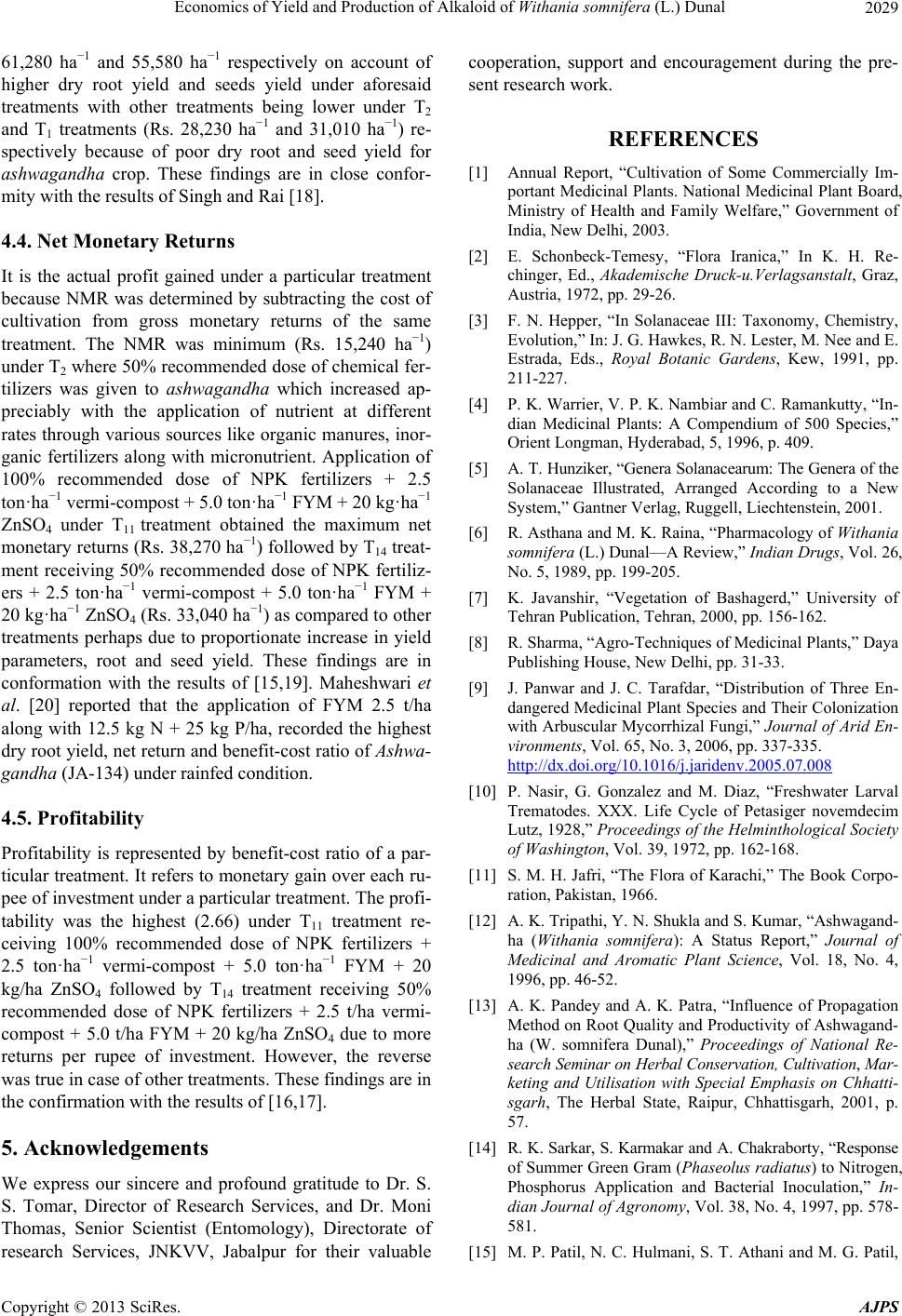 Economics of Yield and Production of Alkaloid of Withania somnifera (L.) Dunal 2029 61,280 ha−1 and 55,580 ha−1 respectively on account of higher dry root yield and seeds yield under aforesaid treatments with other treatments being lower under T2 and T1 treatments (Rs. 28,230 ha−1 and 31,010 ha−1) re- spectively because of poor dry root and seed yield for ashwagandha crop. These findings are in close confor- mity with the results of Singh and Rai [18]. 4.4. Net Monetary Returns It is the actual profit gained under a particular treatment because NMR was determined by subtracting the cost of cultivation from gross monetary returns of the same treatment. The NMR was minimum (Rs. 15,240 ha−1) under T2 where 50% recommended dose of chemical fer- tilizers was given to ashwagandha which increased ap- preciably with the application of nutrient at different rates through various sources like organic manures, inor- ganic fertilizers along with micronutrient. Application of 100% recommended dose of NPK fertilizers + 2.5 ton·ha−1 vermi-compost + 5.0 ton·ha−1 FYM + 20 kg·ha−1 ZnSO4 under T11 treatment obtained the maximum net monetary returns (Rs. 38,270 ha−1) followed by T14 treat- ment receiving 50% recommended dose of NPK fertiliz- ers + 2.5 ton·ha−1 vermi-compost + 5.0 ton·ha−1 FYM + 20 kg·ha−1 ZnSO4 (Rs. 33,040 ha−1) as compared to other treatments perhaps due to proportionate increase in yield parameters, root and seed yield. These findings are in conformation with the results of [15,19]. Maheshwari et al. [20] reported that the application of FYM 2.5 t/ha along with 12.5 kg N + 25 kg P/ha, recorded the highest dry root yield, net return and benefit-cost ratio of Ashwa- gandha (JA-134) under rainfed condition. 4.5. Profitability Profitability is represented by benefit-cost ratio of a par- ticular treatment. It refers to monetary gain over each ru- pee of investment under a particular treatment. The profi- tability was the highest (2.66) under T11 treatment re- ceiving 100% recommended dose of NPK fertilizers + 2.5 ton·ha−1 vermi-compost + 5.0 ton·ha−1 FYM + 20 kg/ha ZnSO4 followed by T14 treatment receiving 50% recommended dose of NPK fertilizers + 2.5 t/ha vermi- compost + 5.0 t/ha FYM + 20 kg/ha ZnSO4 due to more returns per rupee of investment. However, the reverse was true in case of other treatments. These findings are in the confirmation with the results of [16,17]. 5. Acknowledgements We express our sincere and profound gratitude to Dr. S. S. Tomar, Director of Research Services, and Dr. Moni Thomas, Senior Scientist (Entomology), Directorate of research Services, JNKVV, Jabalpur for their valuable cooperation, support and encouragement during the pre- sent research work. REFERENCES [1] Annual Report, “Cultivation of Some Commercially Im- portant Medicinal Plants. National Medicinal Plant Board, Ministry of Health and Family Welfare,” Government of India, New Delhi, 2003. [2] E. Schonbeck-Temesy, “Flora Iranica,” In K. H. Re- chinger, Ed., Akademische Druck-u.Verlagsanstalt, Graz, Austria, 1972, pp. 29-26. [3] F. N. Hepper, “In Solanaceae III: Taxonomy, Chemistry, Evolution,” In: J. G. Hawkes, R. N. Lester, M. Nee and E. Estrada, Eds., Royal Botanic Gardens, Kew, 1991, pp. 211-227. [4] P. K. Warrier, V. P. K. Nambiar and C. Ramankutty, “In- dian Medicinal Plants: A Compendium of 500 Species,” Orient Longman, Hyderabad, 5, 1996, p. 409. [5] A. T. Hunziker, “Genera Solanacearum: The Genera of the Solanaceae Illustrated, Arranged According to a New System,” Gantner Verlag, Ruggell, Liechtenstein, 2001. [6] R. Asthana and M. K. Raina, “Pharmacology of Withania somnifera (L.) Dunal—A Review,” Indian Drugs, Vol. 26, No. 5, 1989, pp. 199-205. [7] K. Javanshir, “Vegetation of Bashagerd,” University of Tehran Publication, Tehran, 2000, pp. 156-162. [8] R. Sharma, “Agro-Techniques of Medicinal Plants,” Daya Publishing House, New Delhi, pp. 31-33. [9] J. Panwar and J. C. Tarafdar, “Distribution of Three En- dangered Medicinal Plant Species and Their Colonization with Arbuscular Mycorrhizal Fungi,” Journal of Arid En- vironments, Vol. 65, No. 3, 2006, pp. 337-335. http://dx.doi.org/10.1016/j.jaridenv.2005.07.008 [10] P. Nasir, G. Gonzalez and M. Diaz, “Freshwater Larval Trematodes. XXX. Life Cycle of Petasiger novemdecim Lutz, 1928,” Proceedings of the Helminthological Society of Washington, Vol. 39, 1972, pp. 162-168. [11] S. M. H. Jafri, “The Flora of Karachi,” The Book Corpo- ration, Pakistan, 1966. [12] A. K. Tripathi, Y. N. Shukla and S. Kumar, “Ashwagand- ha (Withania somnifera): A Status Report,” Journal of Medicinal and Aromatic Plant Science, Vol. 18, No. 4, 1996, pp. 46-52. [13] A. K. Pandey and A. K. Patra, “Influence of Propagation Method on Root Quality and Productivity of Ashwagand- ha (W. somnifera Dunal),” Proceedings of National Re- search Seminar on Herbal Conse rvation, Cultivation, Mar- keting and Utilisation with Special Emphasis on Chhatti- sgarh, The Herbal State, Raipur, Chhattisgarh, 2001, p. 57. [14] R. K. Sarkar, S. Karmakar and A. Chakraborty, “Response of Summer Green Gram (Phaseolus radiatus) to Nitrogen, Phosphorus Application and Bacterial Inoculation,” In- dian Journal of Agronomy, Vol. 38, No. 4, 1997, pp. 578- 581. [15] M. P. Patil, N. C. Hulmani, S. T. Athani and M. G. Patil, Copyright © 2013 SciRes. AJPS  Economics of Yield and Production of Alkaloid of Withania somnifera (L.) Dunal Copyright © 2013 SciRes. AJPS 2030 “Response of New Tomato Genotype Megha to Integrat- ed Nutrient Management,” Advanced Agricultural Re- search of India, Vol. 9, 1998, pp. 39-42. [16] Annual Report, “Twenty Five Years of Research Medici- nal and Aromatic Plants 1975-2000 AICRP on Medicinal and Aromatic Plants JNKVV,” College of Agriculture, Indore (M.P.), 2000, pp. 19-20. [17] A. K. Barik, A. Das, A. K. Giri and G. N. Chottopadhyay, “Effect of Integrated Plant Nutrient Management on Growth, Yield and Production of Wet Season Rice,” Indian Jour- nal Agricultural Sciences, Vol. 76, No. 11, 2006, pp. 657- 660. [18] R. R. Singh and B. Rai, “Effect of Chemical Fertilizers, Organic Manures and Soil Amendments on Production and Economics of Rice-Wheat Cropping System,” Re- search on Crops, Vol. 8, No. 3, 2007, pp. 530-532. [19] K. Barik, A. Raj and R. K. Saha, “Yield Performance, Economics and Soil Fertility through Organic Sources (Vermi-Compost) of Nitrogen as Substitute to Chemical Fertilizers in Wet Season Rice,” Crop Research, Vol. 36, No. 1-3, 2008, pp. 4-7. [20] S. K. Maheshwari, R. K. Sharma and S. K. Gandrade, “Response of Ashwagandha (W. somnifera (L.) Dunal) to Organic Manure and Fertilizer in a Shallow Black Soil under Rain Fed Condition,” Indian Journal of Agronomy, Vol. 45, No. 1, 2000, pp. 70-72. Abbreviation: INM—Integrated Nutrient Management; DAS—Days after Sowing; NPK—Nitrogen, Phosphorus, Potassium; *100% NPK (RDF)—40:20:20 kg/ha; **FYM—Farm Yard Manure; ***NOC—Neem Oil Cake; RDF—Recommended Dose of Fertilizer; m-Meter, asl- above sea level, T1-T14-Treatments.
|